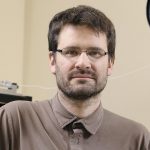Researchers
- Systems science and complex networks
- Mathematical epidemiology
- Statistical physics
- Nanocrystal synthesis
- Study of the quantal excitonic and photonic properties of nanocrystals
- Optimization of nanocrystals and their biofunctionalization with encapsulation
- Imaging and spectroscopy in biological media
- Marine biodiversity and ecosystem functioning
- Impacts of global changes on marine ecosystems
- Benthic invertebrates
- Ecology of disturbances
- Interaction between aquaculture and the environment

- Propagation of solar radiation in natural environments, and in particular in aquatic environments (ocean, lakes, ice floes)
- Light-matter interaction in natural environments: absorption and diffusion by seawater constituents, fluorescence, photosynthesis
- Optical remote sensing of the ocean
- Climate change, marine ecosystems, carbon flux
- Polar environments

- Physics of ionizing radiation
- Medical physics
- Dosimetry and scintillation detectors
- Calculation by Monte Carlo method
- Imaging-guided radiotherapy

- Bioanalytical chemistry and molecular spectroscopy
- Development of optical biosensors for the detection of infectious agents and biomarkers (screening for genetic mutations, and for pharmacogenomics)

- Structure-function study of ion channels by combining several techniques such as molecular biology, electrophysiology, fluorescence as well as the use of pharmacological tools.
- Determination at the molecular level of the involvement of different regions of the ion channels responsible for certain biophysical characteristics through electrophysiological and fluorescence measurements.

- Pathogenic bacteria
- The host-pathogen relationship
- Phagocytosis
- Comparative genomics

- Development and use of microscopy and spectroscopy techniques for imaging and studying neurons, brain and other living tissues
- Studies of Neural Dynamics and Stem Cell Migration in the Brain
- Techniques used: one and two photon fluorescence, second harmonic emission for measuring the action potential of neurons, and coherent Raman for molecular imaging with or without fluorescent agents

- Characterization of the catalytic cycle and reaction intermediates formed by heme proteins, mainly nitric oxide synthases
- Use of lasers for the identification, by time-resolved Raman resonance spectroscopy, of oxygenated intermediates of these enzymes
- Identification of amino acids important for the association and dissociation kinetics of the substrates of these enzymes by laser photolysis.

- Aquatic viral ecology
- Microbial oceanography
- The Arctic Study

- Cellular and molecular neurobiology and synaptic imaging
- Use and development of optical / photonics tools to image signaling and synaptic remodeling in real time, in order to understand brain function
- Imaging of proteins and molecules in neural networks maintained in culture

- Cellular neurobiology and synaptic physiology
- Development of new optoelectric fiber optic probes for mixed recordings in the intact brain
- New advanced multiphoton microscope methods
- Development of nanoprobes
- Functional imaging in the spinal cord

- Brain and biomedical imaging
- Biophotonics, multi-photon microscopy
- Biophysical modeling
- Brain physiology of blood vessels and oxygenation

- Mathematical modeling of large neural networks
- Structure-function studies

- Detection, characterization and quantification of bioaerosols
- The effects of human exposure to bioaerosols are also being studied
- Approaches developed and used:, molecular biology, laser technologies (autofluorescence, and in situ labeling), flow cytometry, and various physical sampling methods

- Machine learning
- Reinforcement learning
- Bandit algorithms (multi-armed bandits)
- Health related applications

- Method development for machine learning and stochastic optimization
- Deep neural networks, (learning and transfer of representations, meta-learning as well as multitasking learning
- Optimization approaches based on probabilistic models as well as evolutionary algorithms, among others for black box optimization and automatic programming
- Putting these techniques into practice in areas such as digital vision, microscopy, health, energy and transport

- Fiber optic sensors
- Light scattering by composite materials, nanostructured surfaces and organic tissues
- Adaptive imaging with polarization discrimination
- Liquid crystals stabilized by miscible and functional polymers for electro-optical applications
- Nanostructured liquid crystals stabilized by polymerization

- Optical instrumentation
- Spectrometry
- Hyperspectral microscopy
- Instrument calibration
- Signal processing
- Fourier transform spectrometry

- Quantitative description of neurobiological systems in their original environment using conventional fluorescence and super-resolution microscopy
- Multidisciplinary approach combining physics, optics, photonics, neurosciences and mathematics, seeks to better understand the complex biological processes in living cells and tissues
- Study of a broad spectrum of interactions, from molecules to multicellular networks, to elucidate neuronal and glial contributions to brain function
- Role of cerebral plasticity at different stages of brain pathophysiology and the functional effects of associated network remodeling.

- Design of integrated bio-instrumentation systems, CMOS radio frequency microelectronic circuits and new energy harvesting approaches
- Integration and personalized development of multi-chip and multi-technology microsystems
- Development of innovative microelectronic platforms to collect and study brain activity using advanced multimodal bio-instrumentation and actuation technology (development of the first wireless brain-computer interface to combine optogenetics and large scale brain monitoring capabilities in a single electronic implant to study brain microcircuits of transgenic rodents behaving freely in real time)

- Development and use of viral vectors for the transfer and expression of genes in nerve cells in vivo and in vitro
- Expression of fluorescent markers, fluorescent indicators of calcium and chlorine, bicistronic vectors, fusion proteins, cloning and expression of genes encoding the hypervariable region of antibodies

- Dynamic modeling of biological systems; Cell signaling pathways and regulation; Synaptic plasticity of neurons
- Models of the interactions between electrophysiology and biochemistry of neurons
- Spatial modeling and diffusion phenomena
- Development of computer tools for simulation data analysis

- Creation and evaluation of new light sources (particular spectral color) in order to influence the biological clock in humans
- Applications of these light sources in order to facilitate adaptation to night work

- 2D and 3D artificial vision sensors (active and stereos)
- Analysis of biomedical images
- Simulation software architectures
- Virtual reality and physics-based simulation

- Development of intelligent nanoscopy methods
- Study of molecular interactions related to synaptic plasticity

- Design, synthesis and characterization of conjugated polymers for applications in the field of organic electronics
- Development of electroactive polymers and electro-optical devices

- Cellular and molecular neurobiology
- Study of dopaminergic neuronal circuits
- Development and use of large volume 3D imaging system (lightsheet) on clarified brains (CLARITY, IDISCO)

- Study of the causes of diabetes such as obesity, diet or inheritance
- Genetic and molecular determinants of resistance to insulin, a condition often seen in overweight people with impaired sugar and fat metabolism
- Development of new therapeutic targets in the framework of preclinical and clinical studies, in particular using biological markers and new diagnostic tools
- Impact of nutrition and other environmental factors on the gut microbiota, a new key “organ” in the regulation of energy metabolism, which plays a determining role in the development of metabolic syndrome

- Development and use of imaging platforms based on digital holographic microscopy and integrating different modalities (fluorescence, electrophysiology, two-photon microcopy, high-throughput screening) for the identification of biomarkers of major psychiatric diseases to facilitate diagnosis and prevention in young people
- Patient-derived induced pluripotent human stem cells (hiPSCs) differentiation and cell culture to study the cellular and molecular mechanisms underlying the onset of major psychiatric illnesses

- Study of new glass materials for the development of microstructured fibers, fiber lasers and optical devices
- Advanced materials from bacterial cellulose for medical applications
- Multifunctional optical materials (organic light emitting diodes)
- Production of thin films

Mario Méthot, adjunct professor, biochemistry, microbiology, and bio-informatics
- Biophysics of membranes
- Membrane lipids
- Model membrane systems
- Protein-membrane and biophotonics interactions
- Visual system; retinoid cycle
- Fluorescence and infrared spectroscopy

- Characterization of bacteriophages; integrative approach (combining data from genomics, transcriptomics, proteomics, and structural biology) to understand the interactions between phages and bacteria
- Development of new tools to eliminate bacteriophages in dairy fermentations and also to optimize their use as antibacterials in various industrial and public health sectors

- Molecular biology
- Production of viral vectors
- Immunology
- Virology

- Cellular and molecular mechanisms involved in neuronal degeneration
- Parkinson’s disease and the compensatory mechanisms that sets up and underlie the dyskinesias induced by Levodopa, the main pharmacological treatment for Parkinson’s disease.
- Combination of neuromorphological, neurochemical, electrophysiological and biophotonic studies to understand the involvement of the rearrangement of the neuronal microcircuitry in the expression of motor symptoms in Parkinson’s disease

- Science and technology of lasers
- Non-linear optics
- Development of femtosecond lasers and high temporal and spatial resolution imaging with these lasers, in order to improve the resolution limit of conventional microscopy
- Application to the visualization of cellular substructures

- Study of the transmission of affective signals between various brain nuclei of the limbic system
- Optogenetic approaches for the manipulation of neuronal pathways ex vivo and in vivo
- Fiber optic photometry measurements to measure the activity of neural pathways in free-moving mice
- Electrophysiological measurements of synaptic transmission on brain slices

- Study of the biophysics of the bacterial flagellar motor
- Use of advanced optical technologies such as ultra-short laser pulse ablation and specific marking of submicrometric structures (with fluorescent nanoparticles) to visualize their rotation

- Materials chemistry
- Modification of surfaces; synthesis and characterization of luminescent nanoparticles
- Organization of polymers at interfaces; organization of nanoparticles at interfaces

Skin photobiology
- Influence of the dermis on the repair efficiency of mutagenic UV-induced damage to the epidermis
- Effect of chronic UVB irradiation on the cellular response to genotoxic stress
- Necroptosis as a new pathway for UV-induced programmed cell death
- Involvement of UVA alone and in synergy with polycyclic aromatic hydrocarbons (PAH) contained in cigarette smoke in skin photoaging
Ocular photobiology
- Toxicity of UVA rays on the cornea, implication of UV-induced oxidation
- Implication of mitochondrial dysfunction in Fuchs’ corneal endothelial dystrophy
- Involvement of blue light alone or in synergy with lipofuscin and / or PAHs on age-related macular degeneration (AMD)

- Study of the molecular and cellular mechanisms of migration and maturation of newly generated neurons in the adult brain
- Combination of molecular, neuroanatomical, electrophysiological and biophotonic studies to understand how neural stem cells produce real neurons and how they are transported to their place of action and integrated into neural networks

- use of different spectroscopic and microscopic techniques to understand how the organization and orientation of molecules play an important role in different stages of the visual arousal mechanism, including both light absorption, retinoid cycling , phagocytosis of photoreceptors as well as the involvement of other cell types in these complex processes

- Development of new optical design, assembly and metrology techniques allowing increased resolution (below diffraction limit) and functionality using complex optical components, such as microlenses, active optics and masks.
- High resolution camera metrology and calibration
- Development of new active lighting systems using LEDs, particularly for neurophotonics applications

- Synaptic plasticity in the various types of neurons of the central nervous system
- Dendritic integration in GABAergic inhibitory neurons
- Cellular and molecular mechanisms, regulation and functional significance of calcium signaling at excitatory synapses of neurons
- Use of a combination of two-photon microscopy techniques, patch clamp electrophysiology, pharmacology and molecular approaches, for the study of the dynamic and functional organization of dendritic signaling essential for learning, memory and other higher cognitive functions.

- Development of components based on optical fibers, in particular visible and infrared fiber lasers
- Biomedical applications of these components
- Development of micro-probes for the recording of electrophysiological signals as well as the development of broadband and short wavelength sources for cell imaging

- Study of lakes, rivers and coastal oceans, with emphasis on high latitude ecosystems
- Special interest in the diversity of aquatic life at the base of food webs and how aquatic ecosystems respond to environmental changes
- Laboratory and field studies on:
- Ecology, diversity and physiology of cyanobacteria
- Underwater light, UV effects and photosynthesis
- Aquatic biogeochemistry and photochemistry
- Trophic ecology of rivers, lakes and ponds
- Microbial biodiversity and function
- Impacts of climate change

- Bio-organic and supramolecular organic chemistry
- Isolation, identification and synthesis of natural products from nordicity
- Biomimetic green chemistry
- Ion channels and membrane transport



